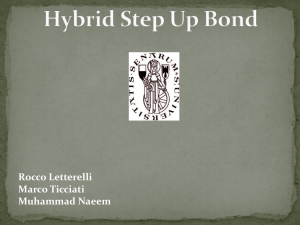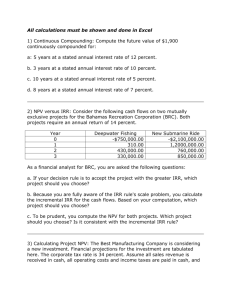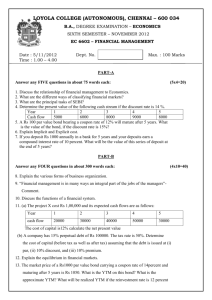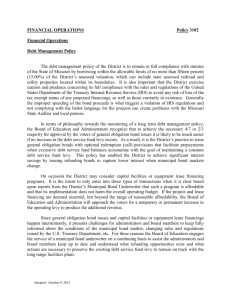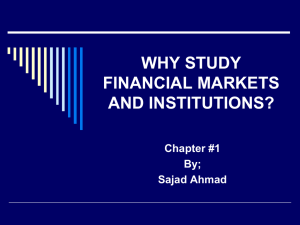BEM 103 Introduction to Finance
advertisement
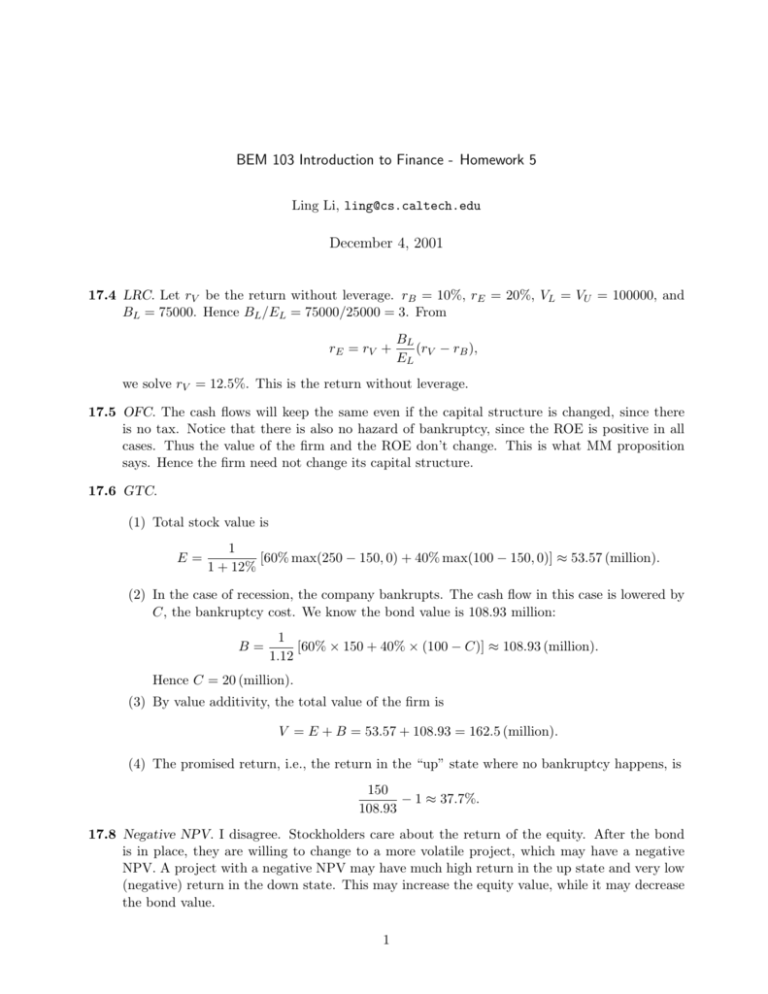
BEM 103 Introduction to Finance - Homework 5 Ling Li, ling@cs.caltech.edu December 4, 2001 17.4 LRC. Let rV be the return without leverage. rB = 10%, rE = 20%, VL = VU = 100000, and BL = 75000. Hence BL /EL = 75000/25000 = 3. From rE = rV + BL (rV − rB ), EL we solve rV = 12.5%. This is the return without leverage. 17.5 OFC. The cash flows will keep the same even if the capital structure is changed, since there is no tax. Notice that there is also no hazard of bankruptcy, since the ROE is positive in all cases. Thus the value of the firm and the ROE don’t change. This is what MM proposition says. Hence the firm need not change its capital structure. 17.6 GTC. (1) Total stock value is E= 1 [60% max(250 − 150, 0) + 40% max(100 − 150, 0)] ≈ 53.57 (million). 1 + 12% (2) In the case of recession, the company bankrupts. The cash flow in this case is lowered by C, the bankruptcy cost. We know the bond value is 108.93 million: B= 1 [60% × 150 + 40% × (100 − C)] ≈ 108.93 (million). 1.12 Hence C = 20 (million). (3) By value additivity, the total value of the firm is V = E + B = 53.57 + 108.93 = 162.5 (million). (4) The promised return, i.e., the return in the “up” state where no bankruptcy happens, is 150 − 1 ≈ 37.7%. 108.93 17.8 Negative NPV. I disagree. Stockholders care about the return of the equity. After the bond is in place, they are willing to change to a more volatile project, which may have a negative NPV. A project with a negative NPV may have much high return in the up state and very low (negative) return in the down state. This may increase the equity value, while it may decrease the bond value. 1 18.2 Bond issue. The value of the company will increase by the debt tax shield. • If the debt issue is a thing of one period, then at the end of one period, coupon rBL is issued, where r = 10% and BL = 1 million. VL = VU + τc rBL 30% × 10% × 1 = 3.5 + ≈ 3.527 (million). 1+r 1 + 10% Thus the new value of the equity is EL = VL − BL ≈ 2.527 (million). • If the debt is perpetual and risk free, we have VL = VU + τc BL = 3.5 + 30% × 1 = 3.8 (million). Thus EL = VL − BL = 2.8 (million). 18.6 NORSK. Let pu be the price-state probability of the “up” state. Solving 100 = 1 [150pu + 50(1 − pu )] , 1 + 10% we get pu = 0.6. (1) Due to the tax shield from the bond coupon, which is 5 in the “up” state and 2.5 in the “down” state, the firm value is now VL = 100 + 1 [0.6 × 5 + 0.4 × 2.5] ≈ 103.6. 1 + 10% (2) In the “up” state, the bond holder will get 110; while in the “down” state, they will only get 50. Thus the value of bond is BL = 1 [0.6 × 110 + 0.4 × 52.5] ≈ 79.1. 1 + 10% Note that the value of the company at the “down” state is increased to 52.5, due to the tax shield. By APV, the value of the firm is VL = 100 + τc BL ≈ 139.5. (3) The two VL ’s in (1) and (2) are different, due to the wrongly using of VL = VU + τc BL in (2). The above equation is correct only when BL = Cr . That is, first, the debt is perpetual with per-period coupon C, and second, there is no risk. This is not true for this problem. 2


